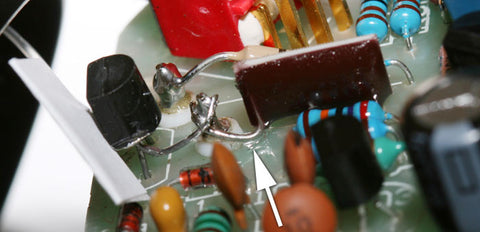Insulate High-Impedance Connections
In a FET-based condenser microphone, the gate pin of the JFET operates at high impedance. To keep noise out of this circuit, the high-impedance connections should not touch the surface of the circuit board.
In most microphones, you'll see the capsule wire connected to a vertical pin that is insulated from the circuit board with a Teflon insert. These connections are not soldered to the surface of the circuit board, but rather are soldered in the air. That's because air is a better insulator than circuit board material is.
Read more about "dead bug" soldering technique, from Jim Williams.
Pictured below is an example of a failed attempt to isolate the mic's high-impedance input connection from the surface of the circuit board. The Teflon-insulated standoff is there, but one leg of the 1G resistor is touching the circuit board!

Also, it's none too clean.
As a result, this mic is noisier than it should be.
The fix is easy: bend that resistor pin so it doesn't touch the circuit board. Then scrub the entire area with flux cleaner or 99% Isopropyl alcohol: the JFET body and pins, the Teflon-insulated terminal, the 1G resistor body and pins. I would resolder the joint where the JFET pin connects to the 1G resistor at that insulated terminal, then clean the joint with flux cleaner.
Conformal Coating

Once a microphone has been tested to confirm that it does not have noise problems caused by contaminated input joints, those input joints should be protected against future contamination.
First, scrub them clean, as described above. Use a commercial flux cleaner or 99% Isopropyl Alcohol. Do not use diluted alcohols as they will contaminate the board.
Then pluck away any stray fibers from the cotton swab used to polish those solder joints.
Note: do not use spray cleaners on the PCB as they might destroy the capsule!
Finally, once the input joints are clean, dry, and have passed an audio test, paint them with acrylic conformal coating to seal out moisture and contaminants.
For a specific product recommendation, see the listing on this page.
Have more tips? Send 'em in; we'll publish them here!
More DIY Electronics Tips
